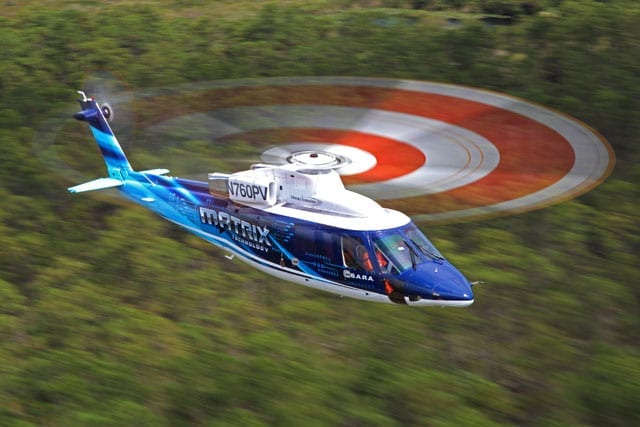
It’s a frontier that’s ripe for autonomous technologies
In 2009, Popular Mechanics gave a Breakthrough Award to Sikorsky’s X2 Technology Demonstrator, a dual-rotor, coaxial helicopter that could fly nearly twice as fast as other vertical take-off and landing (VTOL) vehicles. Now the same research department has announced it is developing software and hardware called Matrix intended to “improve significantly the capability, reliability, and safety” of autonomous VTOL aircraft.
Autonomous fixed-wing aircraft are advancing rapidly. Just last month, the Navy’s fighter jet-sized drone, the X-47B, successfully landed on an aircraft carrier without the help of a human pilot—a notable achievement considering aircraft carrier landings are arguably a pilot’s most difficult task. But rotorcraft autonomy is advancing more slowly. That’s because while fixed-wing aircraft tend to fly in open air, thousands of feet off the ground, helicopters are more likely to find themselves in the thick of things. They fly low and have to contend with vegetation, rocks and other obstacle-cluttered environments, and bad weather and dust storms.
“It’s a frontier that’s ripe for autonomous technologies, but it hasn’t been done in a way that is robust, with reliability and safety,” Sikorsky’s VP of research and engineering Mark Miller tells PopMech.
The company says its Matrix technology research program will build software platforms that are pilot-optional, meaning they could be used for manned and unmanned aircraft, and which could be implemented across a variety of different vehicles. A key to making VTOL autonomous systems safer and more reliable will be to give them a flexible intelligence, so that if a helicopter drone is flying a pre-programmed route and runs into turbulence, the system can adapt to the changing conditions. Such systems will eventually be useful for tasks like patrolling a border, shuttling personnel to and from offshore oil rigs, or for sending on search-and-rescue missions that would endanger a pilot or crew members onboard.
More immediately, autonomy systems could serve as pilots’ aides, taking over low-level tasks and making it safer and easier to fly in rough environments and adverse weather. “With the X2 we can get even closer to the ground and fly even faster” than conventional helicopters, says Chris Van Buiten, Sikorsky’s vice president for technology and innovation.
The Latest Bing News on:
Autonomous Helicopters
- Bell Turns a 429 Helicopter Into a Testbed for Autonomous Flight Technologieson May 9, 2024 at 3:01 am
American helicopter maker Bell presents the Aircraft Laboratory for Future Autonomy (ALFA), a 429 transformed into a testbed for autonomous tech ...
- NASA’s Plans for Next-Generation Mars Helicopters Are Up in the Airon May 8, 2024 at 9:30 am
After the spectacular success of the first-ever “Marscopter,” mission planners have soaring ambitions for follow-up flying machines ...
- EHang’s autonomous eVTOL completes maiden demo flight in UAEon May 7, 2024 at 8:00 pm
EHang's autonomous electric vertical take-off and landing (eVTOL) aircraft has completed its first passenger-carrying demonstration flight in the United Arab Emirates, as the Chinese company eyes the ...
- Autonomous Logistics: Marine Corps Advances Drone Resupply Amid Technological Pushon May 7, 2024 at 12:07 am
T he U.S. Marine Corps is pressing forward with a bold logistical transformation that will see drones playing an ever-greater role in resupplying troops, particularly in the challenging and vast ...
- AI takes flight: Air Force Secretary tests autonomous F-16, eyeing future fleeton May 6, 2024 at 2:41 pm
Frank Kendall, the Secretary of the Air Force in the USA, took to the skies for an hour-long flight in an F-16 fighter jet controlled by artificial intelligence (AI). Cruising at speeds above 560 mph, ...
- BlueHalo and Kraken Partner to Advance Autonomous Maritime Operationson May 6, 2024 at 12:26 pm
BlueHalo, the company transforming the future of global defense, and Kraken Technology Group, a maritime technology leader specializing in disruptive high-performance platforms, today announced a ...
- Air Force Aircraft Incorporates Machine Learning To Test Cutting-Edge Capabilitieson May 6, 2024 at 7:42 am
The most potent feature of the X-62A – called VISTA for Variable In-flight Simulation Test Aircraft – is its new tool for developing and testing flying capabilities in ...
- Reliable Robotics strikes autonomous flight system deal with ASLon May 6, 2024 at 1:00 am
Global aviation services provider ASL Aviation Holdings has placed an order for 30 units of the Reliable Robotics autonomous flight system for the ...
- AF researchers design, build, fly autonomous aircraft in 24 hourson May 3, 2024 at 12:59 am
In support of the ADAX proving ground, the 413th Flight Test Squadron’s Autonomy Prime flight flies autonomous UASs regularly, and new aircraft and autonomy customers come to Eglin to test their ...
- Huge FAA Certification Milestone for the Cento Autonomous Cargo eVTOLon May 2, 2024 at 12:07 am
MightyFly is officially the only large autonomous cargo eVTOL company in the US to have received this particular FAA certification ...
The Latest Google Headlines on:
Autonomous Helicopters
[google_news title=”” keyword=”Autonomous Helicopters” num_posts=”10″ blurb_length=”0″ show_thumb=”left”]
The Latest Bing News on:
Autonomous VTOL aircraft
- Three Different EHang eVTOLs Complete Multiple Autonomous Flights in Abu Dhabion May 7, 2024 at 10:57 pm
May will remain a historic month for autonomous aviation in the UAE. The Chinese eVTOL company EHang completed a pioneering flight in Abu Dhabi as part of an extensive series of d ...
- EHang’s autonomous eVTOL completes maiden demo flight in UAEon May 7, 2024 at 8:00 pm
EHang's autonomous electric vertical take-off and landing (eVTOL) aircraft has completed its first passenger-carrying demonstration flight in the United Arab Emirates, as the Chinese company eyes the ...
- Reliable Robotics strikes autonomous flight system deal with ASLon May 6, 2024 at 1:00 am
Global aviation services provider ASL Aviation Holdings has placed an order for 30 units of the Reliable Robotics autonomous flight system for the ...
- ASL orders 30 Reliable Robotics aircraft autonomy systemson May 6, 2024 at 12:03 am
Goal is to deliver safe and reliable air cargo transport services at a lower operating cost.
- Autonomous Liftoff: China to Mass Produce Pilotless Flying Taxison April 30, 2024 at 12:03 pm
The era of autonomous flying taxis is on the horizon, thanks to EHang securing the world's first production certificate for manufacturing them in China. EHang recently announced that its EH216-S, a ...
- China Green-Lights Mass Production of Autonomous Flying Taxison April 26, 2024 at 6:59 am
China green-lights mass production of autonomous flying taxis. EHang got its first certification and plans to release the first one in 2035.
- China approves first commercial production for autonomous flying taxison April 25, 2024 at 2:54 pm
China has approved the first ever commercial license for large scale manufacture of eVTOL autonomous flying taxis ...
- China green-lights mass production of autonomous flying taxis — with commercial flights set for 2025on April 25, 2024 at 4:00 am
The EHang EH216-S autonomous flying taxi is the first eVTOL ready for mass production and could lead the way for flying cars around the world.
- Radical thinks the time has come for solar-powered, high-altitude autonomous aircrafton April 24, 2024 at 11:52 am
Its high-altitude, solar-powered aircraft aim to succeed where Facebook’s infamous Aquila failed by refining the tech and embracing more markets. It’s hard to believe that Facebook’s ambitious plan to ...
- Mayman Aerospace unveiling first full-scale model of Razor™ P100 military VTOL during SOF Week 2024on April 23, 2024 at 11:32 am
Mayman Aerospace will unveil a full-scale model of Razor, its high-speed Air Utility Vehicle, during SOF Week 2024, May 6-10 in Tampa, Florida. Razor is the name for the military variant of the ...
The Latest Google Headlines on:
Autonomous VTOL aircraft
[google_news title=”” keyword=”autonomous VTOL aircraft” num_posts=”10″ blurb_length=”0″ show_thumb=”left”]









